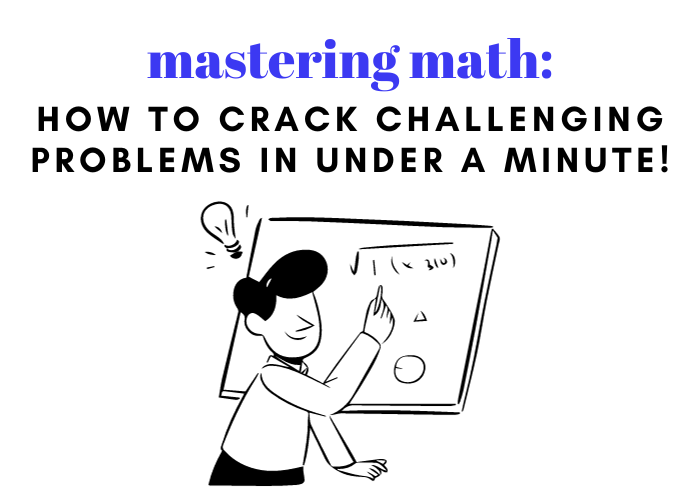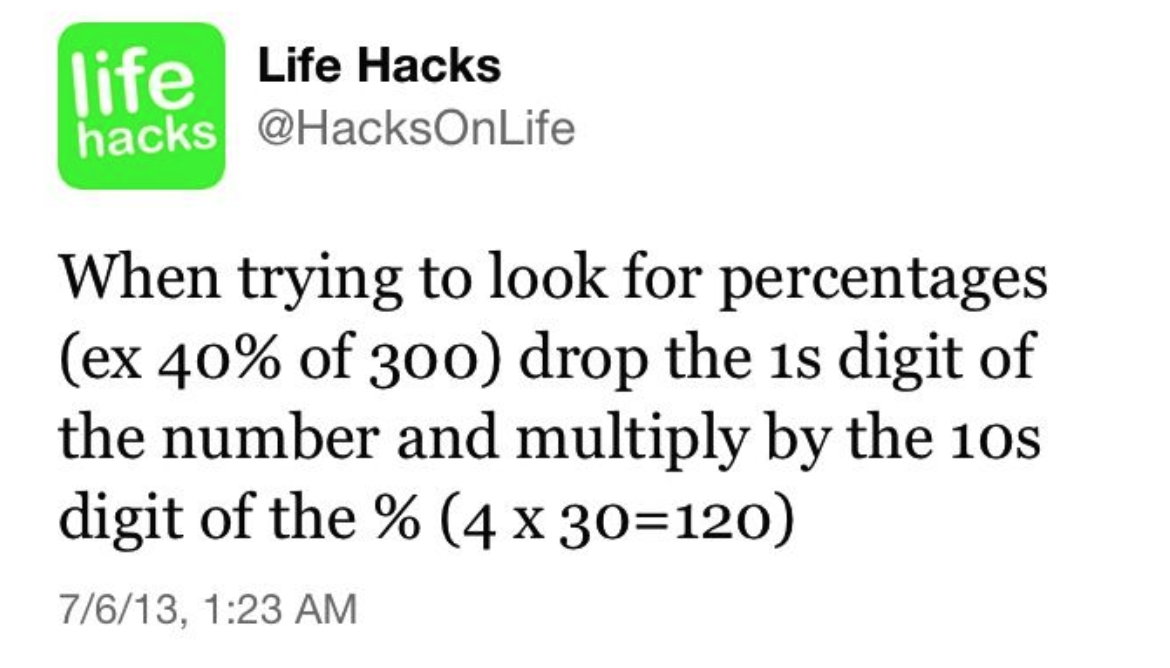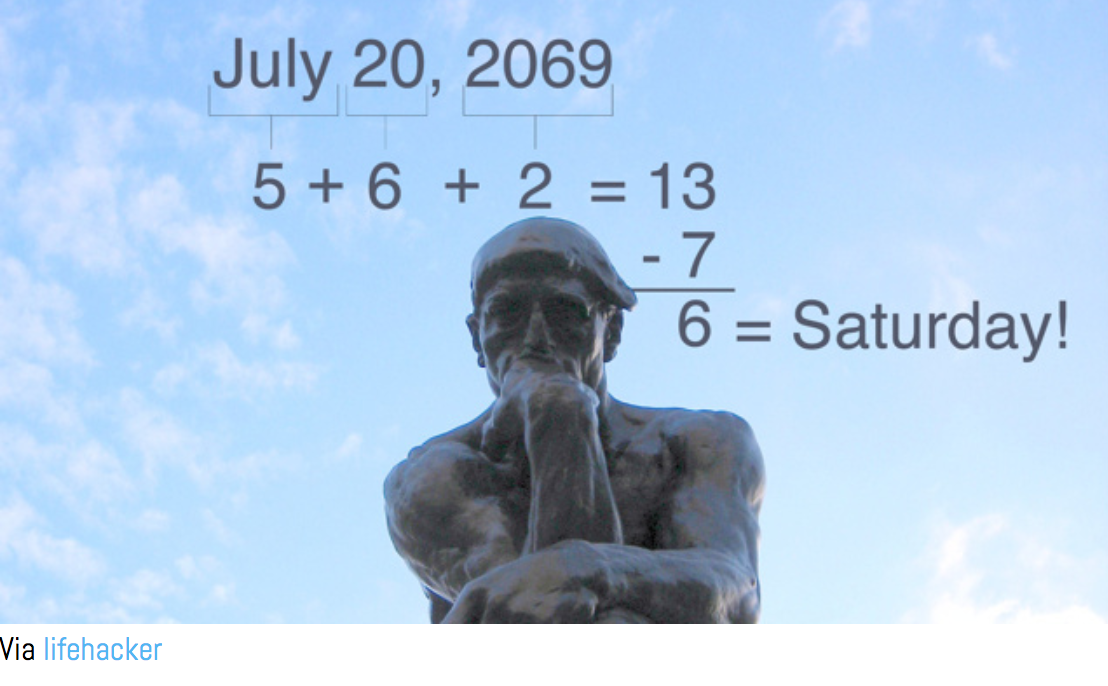

Last Updated on August 3, 2023
There’s more than one way to solve a math problem.
Even the simple ones!
If you ask your child to add 9 and 8 together, they’ll likely start at 9 and hop 8 spaces on a number line to get to 17.
But, your child can also manipulate the numbers to solve the problem differently.
They could double 9 to get 18, then subtract 1 since your starting 8 is one less than 9.
And arming your child with both strategies is important! It allows them to develop stronger number sense and the ability to think non-linearly.
Math hacks are strategies that your child can utilize to solve problems quickly, easily, and simply.
When your child can use math hacks successfully, they become a math champion in the classroom and to their friends!
There’s no reason your child needs to grab a cell phone and open the calculator app to calculate percentages.
In fact, there are actually a handful of helpful math tricks for this one!
One of our favorites is a tweet in March 2019 by Ben Stephens:
Fascinating little life hack, for doing percentages:
x% of y = y% of x
So, for example, if you needed to work out 4% of 75 in your head, just flip it and and do 75% of 4, which is easier.
— Ben Stephens (@stephens_ben) March 3, 2019
So much easier, right?!
And it’s simple math really.
As Ben explains:
It works for the same reason 3 x 5 is the same as 5 x 3. They call it the commutative property– it doesn’t matter which order the terms come in.
— Ben Stephens (@stephens_ben) March 13, 2019
Or, if your child needs to find the percentage of a large number:

Another easy method if your child wants to leave a 15% tip on a bill is to break up the percentage, then add it together again.
Let’s say they want to leave a 15% tip on two pizzas that cost $28.66. Here are the steps:
1. Find out what 10% of the cost is. For this, just move the decimal one place over to the left.
10% of $28.66 is $2.866 — which rounds to $2.87
2. Determine 5% by dividing the 10% calculated amount by 2
$2.87 divided by two is about $1.43
3. Add the 10% amount and 5% amount together to calculate what a 15% tip is
$2.87 + $1.43 = $4.30
And, of course, your child can round the numbers up. So, for step 1, they can use $2.90, which then gives them $1.45 in step 2. This makes for even easier numbers to work with for step 3 – and a nicer tip!
The Butterfly Method is a math trick for adding and subtracting fractions.
The set-up is similar for both operations:
Step 1: Multiply A and D
Step 2: Multiply B and C

Step 3: Multiply B and D
BD becomes the denominator of the fraction.
Then, you either add or subtract BC from AD, depending on what operation the problem calls for!
Here’s a helpful video that shows the butterfly method in motion!
There are a handful of useful divisibility rules that your child should know.
Sure, this helps them speedily answer questions on a math test, but they’ll also likely encounter real-world situations in the future where they can use them!
They might throw a party one day and invite five guests. A quick divisibility check can help them figure out if the guests (plus the host!) can evenly split a cocktail platter with 210 shrimp. (Or if they need to buy a bigger platter!)
There’s no need to take out a calculator when your child can just use these divisibility rules:
Is it divisible by 2?
Yes, if the last digit in the one’s place is divisible by 2.
Is it divisible by 3?
Yes, if the sum of the digits is divisible by 3. (Example: 609 is divisible by 3… 6 + 0+ 9 = 12, and 12 is divisible by 3)
Is it divisible by 4?
Yes, if the last two digits in the number are divisible by 4. (Example: pay attention to just the ’48’ in 627, 948. Since 48 is divisible by 4, then 627,948 is divisible by 4)
Is it divisible by 5?
Yes, if the last digit is a 0 or 5.
Is it divisible by 6?
Yes, if the number is divisible by both 2 and 3.
Is it divisible by 7?
Yes.. if you follow these steps! Remove the last digit from the number, double it, and subtract it from the first part of the number. Do this repeatedly until you get something you recognize as being divisible by 7 or not.
Here’s an example, since that might have sounded rather confusing!
Take the number 728. Remove the “8” and double it. You get 16. Now, subtract 16 from the first two digits (72). You get 56. Is 56 divisible by 7? Yep!
You can learn more about how and why this trick works here.
Is it divisible by 9?
Yes, if the sum of the digits is divisible by 9.
Is it divisible by 12?
Yes, if the number is divisible by both 3 and 4.
There’s an easy and super quick way for your child to multiply 84 by 11!
First, separate the 8 and 4.
84 ? 8 __ 4
Second, add 8 and 4 together.
8 + 4 = 12
Third, plug this number into the space from step 1.
8124
Fourth, if the middle number is greater than 9, then carry the 1 to the hundreds place and add it to the digit there.
For 8124, carry the one and add it 8…. 8+1 = 9.
So, the final answer for 84 x 11 is 924!
So, it may seem eons away, but one day your child is going to start job hunting!
When they do, this math hack helps them compare annual salaries to positions that pay hourly.
(Or, maybe you’re in the midst of a career change and find this tip useful for yourself!)
Let’s say that your child is comparing a job that pays $62,000 a year with a job that pays $35/hour.
If both jobs have your child working the same amount of hours per week, which job pays more?
To quickly and easily compare, your child can change the annual salary to an hourly rate.
First, drop three zeros:
62,000 becomes 62
Second, divide that number by 2:
62 divided by 2 is 31
So, the annual salary job comes to $31/hour.
Looks like that hourly gig for $35/hour is a much better option!
And to find how much an hourly gig pays per year, do the steps in reverse!
$35/hour x 2 = $70
Then add 3 zeros to make that number $70,000
Or… to put it more simply, you either multiply or divide by 2000! This is the same as dropping three zeros and dividing by 2 or multiplying by 2 and tacking on three zeros. Whichever way your child likes to visualize and work through the problem works!
Please note that this hack gives your child a close estimate. It does not give the exact and actual conversion!
So, as a warning, if your child is taking a math test, they shouldn’t use this loose conversion hack for a final answer!
If converting Celsius to Fahrenheit, multiply by 2 and then add 30.
10° Celcius x 2 + 30 = 50?
If converting Fahrenheit to Celsius, subtract 30 and then divide by 2.
80° – 30 and divided by 2 = 25?
The reason that this is a close estimate is that the actual formula requires multiplying by 1.8 and adding 32.
This hack is really just a quick estimate. Your child can use it when traveling or to double-check that their answers on a test actually make sense!
So, this one’s likely not a math hack your child will use on a test.
But, it’s an incredibly cool party trick that’s going to seriously impress your child’s friends!
They’ll think your child is a math genius!
Using a system of codes, your child can take any date and tell someone what day of the week it falls on.

This advanced five-step trick requires a little math and some practice!
There are a few steps and codes, so we’re sharing the link to an article for this one.
Check out this post for all the steps so that your child can really wow their friends!
This last math hack is actually more of an extremely useful tip — especially when your child is taking a standardized test! SAT and ACT tutors recommend this strategy for math problems that involve percentages, ratios, proportions, or variables.
Here’s an example of how making up numbers can help your child answer a question:
Clara is selling her TV for 30% more than what she originally paid for it. After two weeks, she drops the price 50% since no one is buying it. The new price of the TV is what percent of how much she originally paid?
Since your child doesn’t know the actual original price of the TV, they can make up a number to represent what Clara paid for it.
Then, they can use percentages to answer the question.
It usually helps if your child works with an easy number — like 100.
So, if Clara purchased her TV for $100 and started to re-sell it for 30% more than the original cost, then she tried to sell it for $130.
Then, after failing to find a buyer, she drops the listing 50%. This means she cuts the price in half. $130 divided by 2 is $65.
Clara purchased the TV for $100 and is now selling it for $65.
This means that the current selling price of the TV is 65% of the original price.
Maybe your child’s doing okay in math class. With these math hacks, they can really become a math champion by utilizing different strategies and tricks to solve problems!
They can also use these tips to double-check their work on a test. Maybe they have a math test on adding fractions. After solving problems using a strategy that their math teacher showed, they can then double-check their answers using the Butterfly Method!
In addition to using and understanding these awesome math hacks, your child can also become a math champion by working with a math coach!
With a coach, your child can learn a variety of important math and life skills — which help them reach their full learning potential!
You can learn more about how a math tutor can help elevate your child’s performance and make your child a math champion.


